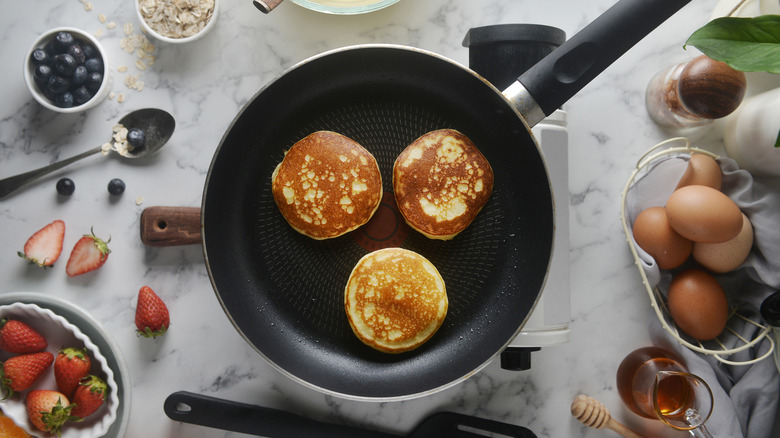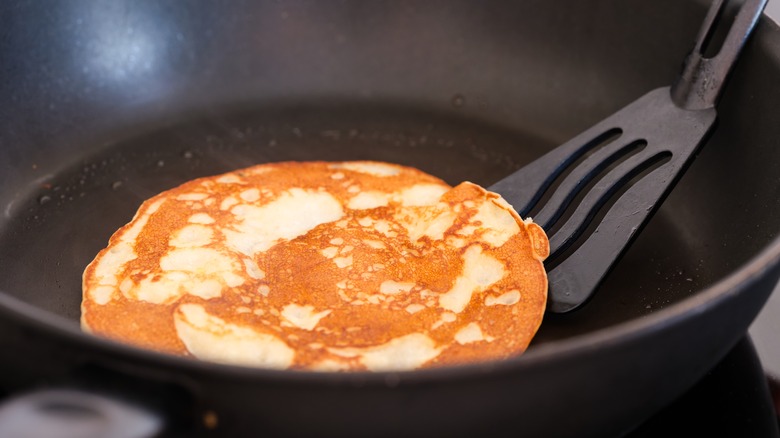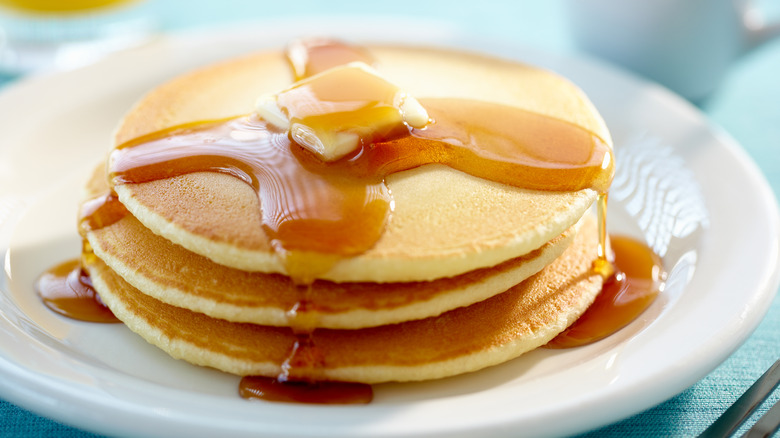The Key To A Splatter-Free Pancake Flip
In the vast world of breakfast delights, there are few dishes as beloved as pancakes. Their smell and sound as they cook on the griddle is the perfect, nostalgic way to start a Saturday morning, and the sight of a short stack drenched in syrup and topped with a few pats of butter is about as iconic as breakfast food gets. Since they only require a few common ingredients, it's easy to make pancakes from scratch, and thanks to the miracle of boxed pancake mix, even the most cooking-averse can whip up some batter in no time. Of course, you'll still have to overcome the obstacle of actually cooking the pancakes, which is where you might run into trouble.
Flipping your flapjacks haphazardly can make the uncooked sides splatter everywhere, coating your kitchen in batter and ruining an otherwise pristine pancake. Even if you perfectly cook one side, all it takes is one errant twitch of the spatula to turn what should have been a fluffy disc into an uneven, unsightly blob. Between aesthetics and ensuring equal cooking times, there are plenty of reasons to master the art of flipping pancakes. Luckily, all it takes is a bit of practice, and a simple twist: Just use the force of two fingers to flip your pancake, not your whole wrist.
The best pancake-flipping technique
Of course, you won't be flipping any pancakes without the right tool. To master this technique, use a small metal spatula with a sharp end that can slide easily under a cooked pancake. Pick the pancake up off the griddle, but don't raise it too high. Bring it about six inches into the air, then gently flip it over to cook on the other side. For the flip itself, you should only move your index finger and thumb. By using your thumb and index finger to decisively twist the spatula, the pancake will be able to fall a short distance back to the griddle without splattering and making a mess.
Flipping pancakes with lots of gusto from your wrist can generate too much kinetic energy, which can push the pancake into the griddle rather than letting it land softly. This excess force causes the batter to splatter outwards and alter the symmetry of your flapjacks. Casually twisting your thumb and forefinger may be less visually impressive than tossing your pancakes high into the air, but it will lead to a more uniform result.
More ways to achieve the perfect pancake
Along with mastering the correct pancake-flipping technique, there are a few other factors to keep in mind if you want to make the pancake stack of your dreams. Start by ensuring you're using the right pan; a nonstick griddle with low edges is your best bet since it will allow you plenty of room to maneuver your spatula under the flapjacks. Speaking of spatulas, you should look for a model with a large, flat end that will keep every centimeter of the picked-up pancake supported.
As with most foods, pancakes are made better with plenty of butter. If you make pancakes regularly, you've likely run into the issue of flapjacks sticking to the griddle, which leaves a burnt mess. To avoid this, add a new pat of butter for each pancake to maximize flavor and to make the process of sliding the spatula between the pancake and griddle effortless. After pouring the batter (which you should let rest beforehand for extra fluffy pancakes), wait until air bubbles start to appear all over the uncooked side before executing the ultimate flip. You should end up with picture-perfect pancakes that are almost too pretty to eat — almost.


